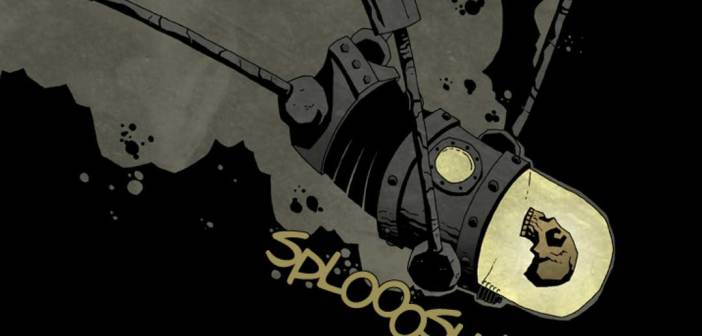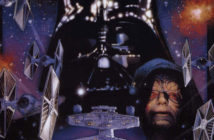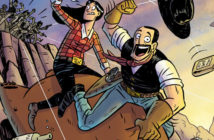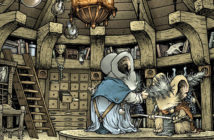If there’s any chance that a rusty robot dredged up from the ocean floor could posses both charm and class, Thomas Hall and Daniel Bradford made it possible in their original comic book title, Robot 13. Hall and Bradford’s creation combines wacky science fiction with classical mythology to build a wholly worthwhile and entertaining tale that all comic book fans will fall in love with.
I recently had the opportunity to speak with Hall and Bradford about Robot 13 and their ambitions in the industry.
Steven Surman: To begin, when did you both first begin to show an interest in comic books?
Thomas Hall: I saw my first comic book before I could read, maybe at age two or three. The first comic I remember getting was an issue of Werewolf by Night that I got my father to buy for me, but my mom objected to something in the book and took it away pretty quick. To silence my crying over losing the book, my dad brought home a stack of stuff: some “Archie” comics, a Spider-Man and a copy of The Hulk that I totally obsessed over.
I begged my dad to read it for me, and he explained to me the concept of word balloons and that it was actually someone’s job to write comics. At that point, I wanted to be a writer of some kind, and I really never wavered from that. Not that it’s been a constant upward path for me, but it’s always been my goal to be a writer, and writing comics is just awesome because they are part of my earliest memories.
Daniel Bradford: For me, it was after college. I hadn’t been up to speed in the comic scene during school, so when I graduated and found myself with some spare time I decided to pick it up again.
SS: When was the leap made from enjoying comics to creating comics?
TH: I started making crude little comic stories when I was little, but I guess a lot of kids do. When I got to college, I fell into a group of friends who wanted to do their own comics, and one of them started an anthology that I did something for, but it never got published because the book folded after issue one. I was a little down about that, but I found that actually doing a comic was great and I loved the whole teamwork aspect of it.
Two of the guys from that group went on to found another anthology called Megazeen, and I did a bunch of stories with them and put out some mini-comics on my own and did a few online things—all real underground stuff. I ended up doing a lot of behind-the-scenes work, and met a lot of other comic artists and writers all doing do-it-yourself books, and it was a great time. What I came away with from all of that was comics are something anyone can do. Sure, you might not have the readership of The X-Men or whatever, but if you love comics, nothing is stopping you from doing them.
DB: It was immediate for me. Illustration and design were my two studies in school and I really enjoyed the idea of using both skills.
SS: What’s the story behind you two joining forces in order to create your premiere title, Robot 13?
TH: Daniel and I have had been working together for a while, and someone approached Daniel about using some of our stuff in a CGI project. The idea was for us to take this robot character that Daniel had designed and weave a whole story around him. I wanted to do a whole Ultraman thing, where the robot would fight all these random giant monsters, and everyone was kind of on board with that for a minute until the project suddenly lost steam and died.
One of the things that killed it, oddly enough, was we had to change the title character’s name because it was already taken, and so I proposed the name Robot 13. The CGI people kind of hated it, and that was the beginning of the end. We walked away with our property, but we basically scrapped everything but our new title and the design of the robot. We liked the idea of him fighting monsters, but we wanted there to be some purpose behind it, and that led to the Greek mythology and everything snowballed from there. It was very organic really, in that the more research I did, the deeper the story became. Everything that I added gave Daniel more ideas as well, and we just kept feeding off of each other’s creativity. Hopefully, as you read each issue, that shows.
DB: It’s also important to note that our debut title was KING! back in 2006. The book was only printed at 200 copies and was sold pretty much only at conventions, though we did fill a number of mail orders as well. But we never actually promoted the book; people heard about it by word of mouth after it’s debut at the Phoenix Comic Con. I don’t really remember why we didn’t go forward with a series immediately, other than I began receiving paid gigs pretty quickly after, but for whatever reason we decided to start on Robot 13 instead. KING! is looking at a series launch in January, though.
SS: I have to say, of all the independent titles I’ve read and reviewed thus far in 2009, Robot 13 is easily my favorite. Where did the inspiration come from to create such a unique book? What were the chief influences that affected you both as you built this bizarrely wonderful character and story?
TH: I read a lot of Greek literature and accounts from the 1800s about the archeology of the Mediterranean and the science of the time, so I knew that would be a part of the story. We wanted to really develop our hero to be, for lack of a better term, a proper British gentleman. He has that cadence to him, and Daniel puts that into his posture and mannerisms. Too often, the central figure of an action story is a one-liner goofball, but I just never saw Robot 13 that way.
On the other hand, he is a classic Greek hero, in that he embodies ideals and is on a journey that is really an introspective journey. While he is moving geographically, his real path is one of learning about himself. That makes him different from a lot of characters in comics, because there is that existential aspect to Robot 13. He’s looking for himself, and he doesn’t know anything more than the reader does.
I also love research, and there were a lot of details I got from my reading that informed Robot 13, but I was equally as inspired by what Daniel was doing with the pages I gave him. Seeing how he interprets things always gives me new ideas. The initial script is always more of a jumping off point than a rigid guideline, because I often see details that get an emphasis than I had envisioned, and most of the time I run with that. For example, when Robot 13 gets attacked by the giant lobster creature towards the end of issue one, in the script all I said was, “A giant sea monster comes up from the depths and chomps on the boat.” When I saw the final page, I immediately said we should have Robot 13 spear a lobster from out of the mass of fish in the nets on the deck. So many people commented on that to us because they thought it said it gave them a feel for the character—that he would take out his feelings on that lobster, and that was something we made up on the fly.
DB: The initial visual design of the robot began as a cover for an underground music magazine called Automata. The drawing was a robot with an exposed human heart and a brain floating in the domed head. A year or so later I drew another robot based off the same idea but used a floating skull instead of a brain and a glowing port hole in place of the heart. Afterwards, I was talking with a computer graphics studio about a possible idea for an animated feature with the robot design and I quickly approached Tom with the drawing and asked him if he could develop a story based off the drawing. Tom did what Tom does and promptly created a universe for the robot. Things eventually fell through with the CG guys and we kept all our original ideas. Later we decided to go forward with a comic series. What has developed currently is barely recognizable with what we were playing with before.
SS: After hashing out your ideas, did you two first shop around the idea to independent comic publishers? If so, what was that like and what reactions did you receive?
TH: Actually, we only really sent it to Image, but they didn’t respond. We don’t even know if anyone saw it, because we found out later that they were going through editorial changes at the time, so it may still be lost in a slush pile somewhere. Sending Robot 13 to Image was something we did because we know a lot of people who work on Image books, and they were all saying: “Image would LOVE this.” We were flattered by all that, but we kind of figured that our book was too quirky. People who love comics get what Daniel and I are doing with the book right away, but when you run a company you want something that you feel is somewhat of a “sure thing.” We didn’t want to make a “safe” book, so we figured we would have to go it alone.
SS: What kind of an undertaking was it to create Blacklist Studios?
TH: We started Blacklist as really just a way to present ourselves to established publishers as we pitched our books, but we saw kind of quickly that if we wanted to do our own material and keep control of it and keep the rights to everything, we had to publish books ourselves. The first couple of things were really just to get our stuff into people’s hands and get a reaction; the original one shot of KING!, for example, had a 250-copy print run and we wound up giving more than half of that away.
Turning Blacklist Studios into an actual business, however, has become quite an undertaking. We had to hire a lawyer and set ourselves up legally as a business, file all the forms with the government, set up a bank account and do all the other things that small businesses have to do. We also had to do all of our usual creative work, find a printer, work with them to get the books actually made, pick them up at customs, publicize the book and find a way to distribute them to stores. On top of all that, we had to reach into our own pockets and find the money to do everything. It has meant a lot of long days with the occasional handful of hours of sleep, and having to keep the ball rolling and produce the next issue.
It’s also meant that we have had to reach out to other people for help, and we have been fortunate to have had some amazing people working with us. Paul Castiglia, a good friend of ours, helped a lot with the publicity and gave us a lot of advice. He’s worked in the comics industry for many years at Archie and a bunch of other places, so he had a lot of insight and has been very helpful. And we turned to Tony Shenton for sales help, which has been amazing. Tony has really pushed the book for us with the retailers, and we owe him a lot as well. It’s a challenge, but so far it’s been worth it.
SS: Your comic demonstrates that there is a lot of talent outside of the major publishers, talent that far exceeds most big-name books printed to simply make a buck. With all you’ve invested in Robot 13, what exactly are you trying to do that hasn’t been done already in comics?
TH: I have always had a love for books outside the mainstream, but a lot of times I feel that some independent titles are a little rushed. Maybe the people working on them are so excited by the creative process, that they don’t take the time to develop things as well as they could. Daniel and I have been working on our material for six years together, so while Robot 13 is new to a lot of people, this is far from a first effort from us. We went through over a year of development on Robot 13, and we are always doing more research and looking to deepen the mythology we are creating and we are looking to push ourselves to make each issue better.
I guess what I was hoping to do was to make a book that had a really subversive, unexpected point of view that was as professional looking and feeling as possible. I can’t be the one to say we have succeeded in doing that, but I think people will let us know how we are doing. Hopefully the readers are satisfied with the result, anyway. That’s really what matters to us. Everything else is gravy, really.
DB: For me, it’s really not about trying to stick out or be different or anything like that. We’ve just got a bunch of stories that we’d like to tell and are overjoyed when so many people stop and pay attention.
SS: How much of the journey of Robot 13 (the character) is going to turn into an epic quest?
TH: Personally, I want to see Robot 13 make it to the end of his hero’s journey and find the answers to all the questions he has. I know some of the stops on that journey, I know the ending I have in mind for him and the high points of the stops along the way, but we are leaving room for us to learn something along the way and include new ideas. The back story of Robot 13 is very rich, and there are so many things we can incorporate into the flow of the plot, that we could keep doing Robot 13 stories for quite some time. That being said, our goal is to do a sequence of miniseries, each of which will be a little step in the direction of the final end we have in mind. Rather than worry about how we can hold on to the character and keep the story going on forever, I want to savor doing the book and give people something they can love and enjoy.
SS: Are there any plans to introduce other bizarre heroes and companions into the odyssey of Robot 13, or perhaps a villain or two with enduring substance?
TH: Characters will reoccur when it makes for a good story, and we will develop some bad guys that pop up as well. What I don’t want to do, however, is build a big supporting cast just because adventure books should have ensemble casts, or whatever. I want to do a good story first, and worry about who stays and who goes based on what serves the story best. I will say, by the end of this miniseries, you will have a few characters to follow into future adventures. And I am sure you will be happy when you see who comes back and how. That’s all I can say at this point, because I don’t want to ruin any surprises.
SS: This question is for Daniel Bradford: I’m sure that you’ve heard time and again that your artwork looks a lot like Mike Mignola’s. How much of an influence was his artistic style on your own.
DB: He’s been very influential. However, if you’ve ever read the Scary Stories to Tell in the Dark series, then you would know who Stephen Gammell is. That gentleman has been far more of an influence than anybody else has. Jae Lee has also been consistently blowing me away; I practically made out with the Ghost Riders #1 cover he did.
SS: I’ve been consistently been blown away by your artwork. The thick lines and rough edges are reminiscent of Mignola, but the physical characteristics of the characters you animate are much livelier than the Hellboy creator’s. They have a sleek, old-world look reminiscent of Kevin O’Neill’s work on The League of Extraordinary Gentlemen. All of those observations aside, how did you find your own unique hand as an artist?
DB: I really doubt that it’s that unique, but it is something that just kind of evolves once you start gaining more and more inspiration from other artists. There are so many artists that feed off of each other and what comes out of it is spectacular. I can’t say that my work is spectacular but I’ve been feeding off of several artists of late. Stephen Gammell always was and always will remain my main dish, though.
SS: Back to the comic as a whole; how has the reception been towards Robot 13 thus far?
TH: I’d say it’s been great. It’s actually very humbling to see how much some people like the book, because we have put so much into Robot 13 and we are so close to it. Concerning the press, the reviews have been so encouraging, and we are happy that people who read books critically find the book to be worth recommending. What is even better for me, though, is the knowledge that we are winning over comic fans with our odd little book.
When we debuted the book at the MoCCA festival in New York a few months back, we had a bunch of people who heard about the book who basically made the trip there to get a copy. It was weird for me, because some of them were buying the book and going and reading it immediately. I remember one specific guy bought the book and sat in the corner and read the whole thing through, maybe even more than once, and came back and was so excited because he had an expectation for the book and we somehow nailed it.
I am finding that we are connecting with people that want something really different, and they respond to the fact that the book doesn’t feel corporate but it’s still professional quality. The big thing for us will be if we can keep that going for issues 2 & 3, and end the mini series as strong as we started it in the eyes of the people that love it. If we can do that, we have succeeded as far as I am concerned.
SS: Is there something you both would like readers to take away from Robot 13?
TH: In classical literature, it was very common for a hero of a story to come away with some revelation about himself because he was open to discovering something. In some ways, we feel we’ve evolved as people since the age of mythology, but I am not so sure all the evolution was for the better.
I guess if I had my way, Robot 13’s desire to learn about himself would rub off, and people would connect with what he is doing and find something that challenges them about their own lives within our little fable. So there is that, but if people aren’t willing to go that far, I’d be happy if they enjoyed the story. It’s really a fun story, even though we try to make it a little more than just that.
DB: I ultimately want people to find enjoyment and satisfaction. All we can do is offer our best in a title. All I want is the knowledge that I entertained some people.
SS: Do you have any other projects planned for the future?
TH: Once Robot 13: Colossus! is done, we are following it with a KING! miniseries. That book is a total departure from Robot 13 in a lot of ways—it’s about a former Mexican professional wrestler who has a persona similar to Elvis, and has retired from the ring to become a monster exterminator for hire. It’s a lot more surreal and blackly humorous than Robot 13, and it’s really just as out there as we can possibly make it. The wrestler’s boss, for example, is a sentient human heart with mechanical spider legs, and his first mission is to retrieve the Spear of Destiny from a horde of Moche zombies who have invaded the local Blubber Tubber Burger restaurant.
Ever since we put out the KING! one-shot a couple of years ago, people have been bugging us for more. While we love Robot 13, we also want people to see “KING!” because it’s just amazingly fun. We have a few other things we’d like to do, including more Robot 13, but KING! will be what occupies the first half of 2010 for us at the very least.
SS: When is the next issue of “Robot 13” going to hit the market?
TH & DB: We were hoping for the last week of September, but it is looking more like the release date will be the first week in October. We are printing the book overseas, so that we can get a very high print quality at a price that keeps us competitive with other books on the market. As a result, you have to deal with ocean shipping and customs and things of that sort. We will announce the actual release date very soon, and we will open up preorders for issue two at that time.
This interview originally appeared on Comic News on 18 September 2009.




